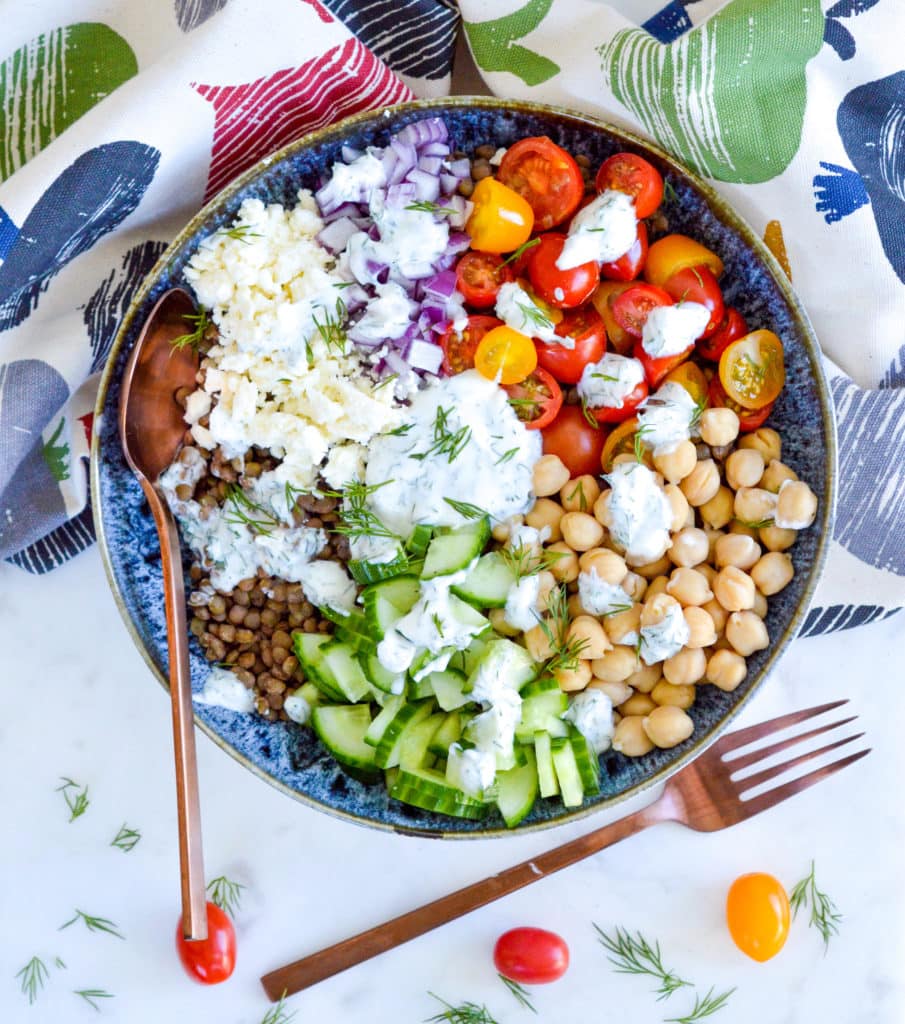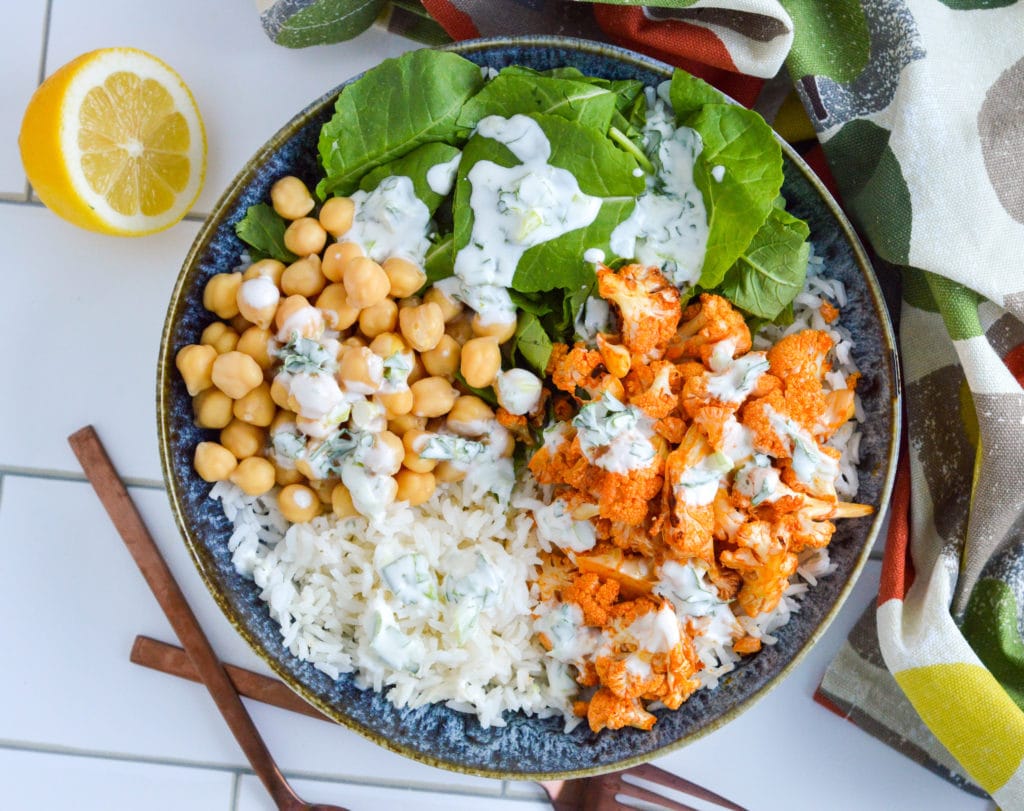Follow this simple 5-step formula to create a healthy vegan bowl with plenty of protein and flavor in 30-minutes or less.
As a plant-based eater and Registered Dietitian, one of my go-to dinners (and lunches) is a vegan bowl. Not only are plant-based bowls easy to make, they are highly customizable. Use whatever ingredients you have in the fridge or pantry, throw them together in a bowl and top with delicious goodies, like sauces and nuts.

Although making a bowl is an easy option, there are certain things that can cause it to go south. For instance, some bowls neglect protein and others are low in the satisfaction and taste department.
But creating the perfect bowl doesn’t have to mean following a complicated recipe. This simple 5-step formula will help you come up with the perfect bowl that suits your tastebuds and appetite. You can choose the ingredients that you like best and experiment with different versions of a plant-based bowl. The possibilities are endless!
And my favorite part is that you can make a big batch of any bowl you like and eat it all week long!
The formula
This simple formula for building a plant-based bowl results in a perfect meal every time. Follow it and tag me on social media @greenletes to show me your creations.
- Choose a base
If you’ve ever visited Chipotle or any quick service restaurant that lets you build your own bowl, you likely know that most bowls usually start with a grain. Chipotle offers brown or white rice. Other places might start with quinoa or farro.
Start there with your bowl. Besides rice, quinoa and farro, try bulgur wheat, wheatberries, spelt, amaranth, or even cooked oats. Whole grains are complex carbs that have plenty of protein and fiber, both of which keep you full. Make sure you consider the portion size of any grain. Usually, ½ cup to 1 cup of cooked grains is plenty.
Or if you prefer to skip the grain, start your bowl with a leafy green. [ Related: How To Add More Leafy Greens Into Your Plant-Based Diet] Chopped kale, spinach, butter leaf lettuce, swiss chard, mixed greens, red leaf lettuce or mixed lettuce are just some of the green options.
- Add a protein
A plant-based protein may be one of the most important elements of a healthy bowl. Protein contributes to muscle growth and appetite control. In other words, adding protein to your bowl will help keep you full for hours.
Choose from the following list of plant-based proteins. Better yet, mix and match a few of these:
- Tofu, Protein: 9 grams in 3 ounces (⅕ of a block)
- Seitan, Protein: 21 grams in ⅓ cup (1 ounce)
- Tempeh, Protein: 16 grams in 3 ounces
- Edamame, Protein: 9 grams of protein in ½ cup
- Black beans, Protein: 14 grams in 1 cup (canned)
- Lentils, Protein: 13 grams in ½ cup cooked
- Hemp seeds, Protein: 10 grams in 3 tablespoons
- Peas, Protein: 5 grams in ⅔ cup
- Amaranth, Protein: 6 grams in ⅔ cup (cooked)
- Oats, Protein: 5 grams in 1/2 cup of dry oats
- Quinoa, Protein: 8 grams of protein in 1 cup cooked
- Chickpeas, Protein: 12 grams in 1 cup (canned)
- White beans, Protein: 12 grams in 1 cup (canned)
- Kidney beans, Protein: 14 grams in 1 cup (canned)
- Flax seeds, Protein: 8 grams in 3 tablespoons
- Black-eyed peas, Protein: 14 grams in 1 cup (canned)
- Add veggies (and/or fruit)
Veggies and fruit aren’t only nutrition powerhouses, they are also packed with flavor. Not to mention that there are so many varieties to choose from. Opt for raw veggies, like shredded cabbage, sliced peppers, diced carrots or chopped onion. Or combine veggies with olive oil and salt and roast them in the oven. Some of my favorites to roast are sweet potatoes, cauliflower, broccoli, beets and green beans.
And if you want some natural sweetness to complement the other nutty and savory flavors, add chopped fruit. Tomatoes, avocados and zucchini are all considered a fruit. But there are other sweet options, like apples, peaches, blueberries, strawberries, watermelon and more!
- Choose your toppings
Now comes the fun part– the toppings! The next addition to your bowl adds texture and flavor. In the Chipotle example, one of the biggest errors os choosing calorie dense toppings, like sour cream or loads of cheese.
Instead, sprinkle your bowl with seeds or nuts. Some of my go-to’s include:
- Pumpkin seeds
- Sunflower seeds
- Flax seeds
- Hemp seeds
- Chopped toasted almonds
- Chopped walnuts
- Chopped peanuts
Or increase the veggie intake ever further and add sliced radishes or a homemade pico de gallo or guacamole.
- Sauce it up
I thought about including sauce in the toppings, but I think sauces should stand on their own. They are really what make or break your dish and add a major flavor component. And remember, the toppings add texture, while the sauces contribute flavor.
You can easily use a bottled sauce, like a teriyaki, sriracha, balsamic glaze, salad dressing or even a dip, like hummus, salsa tzatziki. Or you can make your own sauce. Some of my favorites include a homemade honey mustard, lemon pepper marinade, balsamic vinaigrette, romanesco and pesto.
Just like the rest of your bowl, the sauce possibilities are endless.

How to customize your bowl
Now that you have the easy 5-step formula for making a plant-based bowl, it’s time to customize it even further. Building the bowl was the beginner version, and now we’re moving on to the advanced. Here are ways to make your vegan bowl your own special recipe.
Boost the flavor
The sauces are certainly a flavor boost, but there are many other ways to add flavor to your bowl. These are some suggestions:
- Roast your veggies in spices, like cumin, chili powder, cinnamon, old bay seasoning, curry powder or smoked paprika.
- Utilize herbs, like chopped cilantro, basil, parsley, oregano, thyme, rosemary, mint and others. A little bit of herbs goes a long way.
- If you can handle the heat, add chopped chilies, like jalapenos, serrano or habaneros.
- A little bit of diced chives or scallions can really up the flavor game.
- Drizzle the bowl with olive oil and a squeeze of lime juice. Better yet, use garlic marinated olive oil.
Double up the protein
If you’re training for an athletic event, like a marathon or triathlon, chances are you need more protein to meet your calorie and muscle needs. Or you may be a strength-trained athlete looking for increase muscle gains.
Whatever the reason, increasing the protein in your plant-based bowl can be a good idea. Add a double serving of tofu, legumes, beans or seeds. That said, unless your caloric needs are higher, you’ll likely want to cut back on some of the grains, toppings or sauces, so the calories stay the same.
Carb load
Endurance athletes may need more carbs than the average person, and the standard ½-1 cup of whole grains may not cut it. If you’re carb loading for a race or training at daily high intensity, increase the carbs in your bowl. [Realted: How To Carb Load For A Race}
Double up on the grain or vegetable portion of the bowl for more carbs. Some plant-based proteins, like beans or lentils, also include plenty of carbs. Just be careful not to overdo it on the fiber and cause digestive issues.
Fun extras
You may want to add some fun extras to spice things up. These aren’t all the healthiest options, but they may up the satisfaction factor for you. If adding a little bit of cheese to your bowl makes you happy, go for it. Here are some fun extras:
- Cheese, like fresh mozzarella, goat cheese, feta, burrata or vegan cheese
- Fried onions
- Tortilla chips
- Apple chips
- Falafel
- Pita chips
- Roasted red pepper
- Sun dried tomatoes
- Olives
- Marinated artichokes
- Breadcrumbs
- Pickled vegetables
- Parmesan crisps
Plant-based bowl recipes
Prefer to follow a recipe? I’ve got you covered with these options:
- Southwestern Quinoa Power Bowl
- Mediterranean Bulgur Salad
- Buffalo Cauliflower Rice Bowl
- Barbecue Tempeh Rice Bowl
- Vegan Sushi Quinoa Bowl
- Greek Lentil Power Bowl
- Rainbow Grain Bowl
- Farro Salad with Feta, Brussels Sprouts & Grapes
- Cauliflower Shawarma



0 Comments